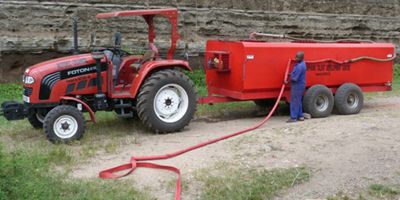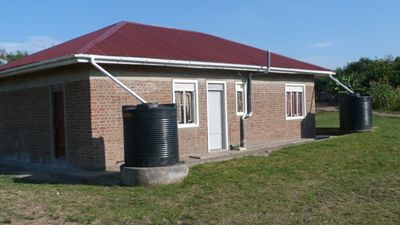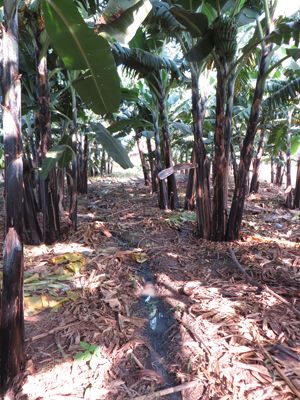Water
NOTDEC Uganda’s site is dry. Even to build the first 4 houses, water had to be hauled 4 km from the river. Elephant grass planted in the hope of grazing cattle died within a year. How could we possibly provide a reliable supply for a large orphanage?
 Well Boring!
Well Boring!
Plan A – drill for water, providing a clean supply under NOTDEC Uganda's own direct control. After a survey, a borehole was drilled. It was dry. Two more were tried, but the drill heads sheared. Further efforts hit even harder rock, and drilling was abandoned.
Pipe Dream
Plan B – piping water from natural springs. This story was set to run and run. Long before NOTDEC, there were plans to pipe water from mountain springs through several villages to Kabirizi. Could it be extended 2km to NOTDEC Uganda — and beyond? Nothing happened.
At last in 2015 a local charity funded from the US is progressing with a 25km pipe from the springs to Kabirizi. Biggest challenges will be stopping villagers tapping the pipe, and meeting the huge demand once water is local not miles away. The charity wants NOTDEC Uganda to benefit from the pipeline and help fund its extension to NOTDEC Uganda and to the next village beyond. Time will tell: given notice, the cost should be manageable - but the whole project might still then take some years to complete. Almost nothing happens quickly in Uganda.
Working Solutions
Talk is cheap: kids need water now.
 Initially, drinking water — in jerry cans — was driven in. Next water was trucked from the river in three 1000 litre tanks using a small pickup and trailer which could shift a total of 3 tons of water per trip. Water was then filtered through Biosand filters.
Initially, drinking water — in jerry cans — was driven in. Next water was trucked from the river in three 1000 litre tanks using a small pickup and trailer which could shift a total of 3 tons of water per trip. Water was then filtered through Biosand filters.
Hauling tons of water this way, however, cost a fortune in fuel, wear & tear, and staff time. The answer was a huge 10,000 litre water bowser trailer — which has to be towed by a tractor (also used on NOTDEC Uganda's farm). Instead of several trips a day, there are just 4 a week.
 For water pressure, a tower was built; then — when more houses were added — it was raised and expanded to 14,000 litres. An Australian Skyhydrant filter removes nasties to ensure potability.
For water pressure, a tower was built; then — when more houses were added — it was raised and expanded to 14,000 litres. An Australian Skyhydrant filter removes nasties to ensure potability.
With a new 2” pump, NOTDEC Uganda again has two good pumps for greater security of supply. In theory, this set up is potentially vulnerable; but it works very well in practice provided everything is properly checked and maintained. And with that, knowing John Leftley is watching helps no end!

Belt & Braces
In the wet season, however, the river is turbid. So, as a fallback, rainwater is collected from all NOTDEC Uganda's buildings: the picture shows the office building. What is more there's also underground water storage — to save it for a rainy day!

And Recycling to Boot!
We even recycle used water from the laundry to irrigate the banana plantation. And that's some plantation!
NOTDEC Uganda's climate is perfect for cooking bananas (matoke) — a staple of the local diet. To Europeans, it can seem a bit like plasticy yellow mashed potato but Ugandans love it. So more bananas are being planted to make the most of the weather, and the water. Eventually, NOTDEC Uganda should produce more bananas than it needs, and will be able to sell the surplus at the local market — generating income to plough back into the welfare of the children. All that just by being careful with used water.
If and when the pipeline is eventually built, recycling water will still make sense. Why take from the community pipeline what the laundry can supply more easily?
